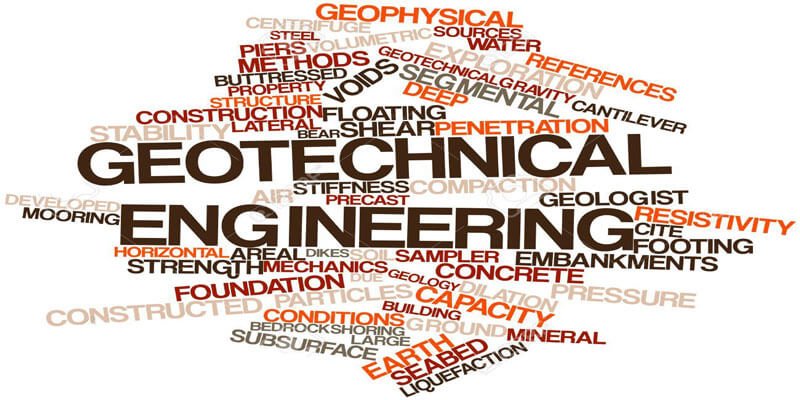Geotechnical engineering, also known as geotechnics, is the application of scientific methods and engineering principles to the acquisition, interpretation, and use of knowledge of materials of the Earth’s crust and earth materials for the solution of engineering problems and the design of engineering works. It is the applied science of predicting the behavior of the Earth, its various materials and processes towards making the Earth more suitable for human activities and development.

Geotechnical engineering embraces the fields of soil mechanics and rock mechanics, and has applications in the fields of geology, geophysics, hydrology, and other related sciences. Geotechnics is practiced by both engineering geologists and geotechnical engineers.
Examples of the application of geotechnics include: the prediction, prevention or mitigation of damage caused by natural hazards such as avalanches, mud flows, landslides, rockslides, sinkholes, and volcanic eruptions; the application of soil, rock and groundwater mechanics to the design and predicted performance of earthen structures such as dams; the design and performance prediction of the foundations of bridges, buildings, and other man-made structures in terms of the underlying soil and/or rock; and flood control and prediction.
Geotechnical engineering is the branch of civil engineering concerned with the engineering behavior of earth materials. Geotechnical engineering is important in civil engineering, but also has applications in military, mining, petroleum and other engineering disciplines that are concerned with construction occurring on the surface or within the ground. Geotechnical engineering uses principles of soil mechanics and rock mechanics to investigate subsurface conditions and materials; determine the relevant physical/mechanical and chemical properties of these materials; evaluate stability of natural slopes and man-made soil deposits; assess risks posed by site conditions; design earthworks and structure foundations; and monitor site conditions, earthwork and foundation construction.[1][2]
A typical geotechnical engineering project begins with a review of project needs to define the required material properties. Then follows a site investigation of soil, rock, fault distribution and bedrock properties on and below an area of interest to determine their engineering properties including how they will interact with, on or in a proposed construction. Site investigations are needed to gain an understanding of the area in or on which the engineering will take place. Investigations can include the assessment of the risk to humans, property and the environment from natural hazards such as earthquakes, landslides, sinkholes, soil liquefaction, debris flows and rockfalls.
A geotechnical engineer then determines and designs the type of foundations, earthworks, and/or pavement subgrades required for the intended man-made structures to be built. Foundations are designed and constructed for structures of various sizes such as high-rise buildings, bridges, medium to large commercial buildings, and smaller structures where the soil conditions do not allow code-based design.
Foundations built for above-ground structures include shallow and deep foundations. Retaining structures include earth-filled dams and retaining walls. Earthworks include embankments, tunnels, dikes and levees, channels, reservoirs, deposition of hazardous waste and sanitary landfills. Geotechnical engineers are extensively involved in earthen and concrete dam projects, evaluating the subsurface conditions at the dam site and the side slopes of the reservoir, the seepage conditions under and around the dam and the stability of the dam under a range of normal and extreme loading conditions.
Geotechnical engineering is also related to coastal and ocean engineering. Coastal engineering can involve the design and construction of wharves, marinas, and jetties. Ocean engineering can involve foundation and anchor systems for offshore structures such as oil platforms.
The fields of geotechnical engineering and engineering geology are closely related, and have large areas of overlap. However, the field of geotechnical engineering is a specialty of engineering, where the field of engineering geology is a specialty of geology. Coming from the fields of engineering and science, respectively, the two may approach the same subject, such as soil classification, with different methods.
Soil mechanics
In geotechnical engineering, soils are considered a three-phase material composed of: rock or mineral particles, water and air. The voids of a soil, the spaces in between mineral particles, contain the water and air.
The engineering properties of soils are affected by four main factors: the predominant size of the mineral particles, the type of mineral particles, the grain size distribution, and the relative quantities of mineral, water and air present in the soil matrix. Fine particles (fines) are defined as particles less than 0.075 mm in diameter.
Building foundations
A building’s foundation transmits loads from buildings and other structures to the earth. Geotechnical engineers design foundations based on the load characteristics of the structure and the properties of the soils and/or bedrock at the site. In general, geotechnical engineers:
Estimate the magnitude and location of the loads to be supported.
Develop an investigation plan to explore the subsurface.
Determine necessary soil parameters through field and lab testing (e.g., consolidation test, triaxial shear test, vane shear test, standard penetration test).
Design the foundation in the safest and most economical manner.
The primary considerations for foundation support are bearing capacity, settlement, and ground movement beneath the foundations. Bearing capacity is the ability of the site soils to support the loads imposed by buildings or structures. Settlement occurs under all foundations in all soil conditions, though lightly loaded structures or rock sites may experience negligible settlements. For heavier structures or softer sites, both overall settlement relative to unbuilt areas or neighboring buildings, and differential settlement under a single structure can be concerns. Of particular concern is a settlement which occurs over time, as immediate settlement can usually be compensated for during construction. Ground movement beneath a structure’s foundations can occur due to shrinkage or swell of expansive soils due to climatic changes, frost expansion of soil, melting of permafrost, slope instability, or other causes.[citation needed] All these factors must be considered during the design of foundations.
Many building codes specify basic foundation design parameters for simple conditions, frequently varying by jurisdiction, but such design techniques are normally limited to certain types of construction and certain types of sites and are frequently very conservative.
In areas of shallow bedrock, most foundations may bear directly on bedrock; in other areas, the soil may provide sufficient strength for the support of structures. In areas of deeper bedrock with soft overlying soils, deep foundations are used to support structures directly on the bedrock; in areas where bedrock is not economically available, stiff “bearing layers” are used to support deep foundations instead.
Shallow foundations
Shallow foundations are a type of foundation that transfers the building load to the very near the surface, rather than to a subsurface layer. Shallow foundations typically have a depth to width ratio of less than 1.
Footings
Footings (often called “spread footings” because they spread the load) are structural elements which transfer structure loads to the ground by direct areal contact. Footings can be isolated footings for point or column loads or strip footings for wall or another long (line) loads. Footings are normally constructed from reinforced concrete cast directly onto the soil and are typically embedded into the ground to penetrate through the zone of frost movement and/or to obtain additional bearing capacity.
Slab foundations
A variant on spread footings is to have the entire structure bear on a single slab of concrete underlying the entire area of the structure. Slabs must be thick enough to provide sufficient rigidity to spread the bearing loads somewhat uniformly and to minimize differential settlement across the foundation. In some cases, flexure is allowed and the building is constructed to tolerate small movements of the foundation instead. For small structures, like single-family houses, the slab may be less than 300 mm thick; for larger structures, the foundation slab may be several meters thick.
Slab foundations can be either slab-on-grade foundations or embedded foundations, typically in buildings with basements. Slab-on-grade foundations must be designed to allow for potential ground movement due to changing soil conditions.
Deep foundations
Deep foundations are used for structures or heavy loads when shallow foundations cannot provide adequate capacity, due to size and structural limitations. They may also be used to transfer building loads past weak or compressible soil layers. While shallow foundations rely solely on the bearing capacity of the soil beneath them, deep foundations can rely on end bearing resistance, frictional resistance along their length, or both in developing the required capacity. Geotechnical engineers use specialized tools, such as the cone penetration test, to estimate the amount of skin and end bearing resistance available in the subsurface.
There are many types of deep foundations including piles, drilled shafts, caissons, piers, and earth stabilized columns. Large buildings such as skyscrapers typically require deep foundations. For example, the Jin Mao Tower in China uses tubular steel piles about 1m (3.3 feet) driven to a depth of 83.5m (274 feet) to support its weight.



